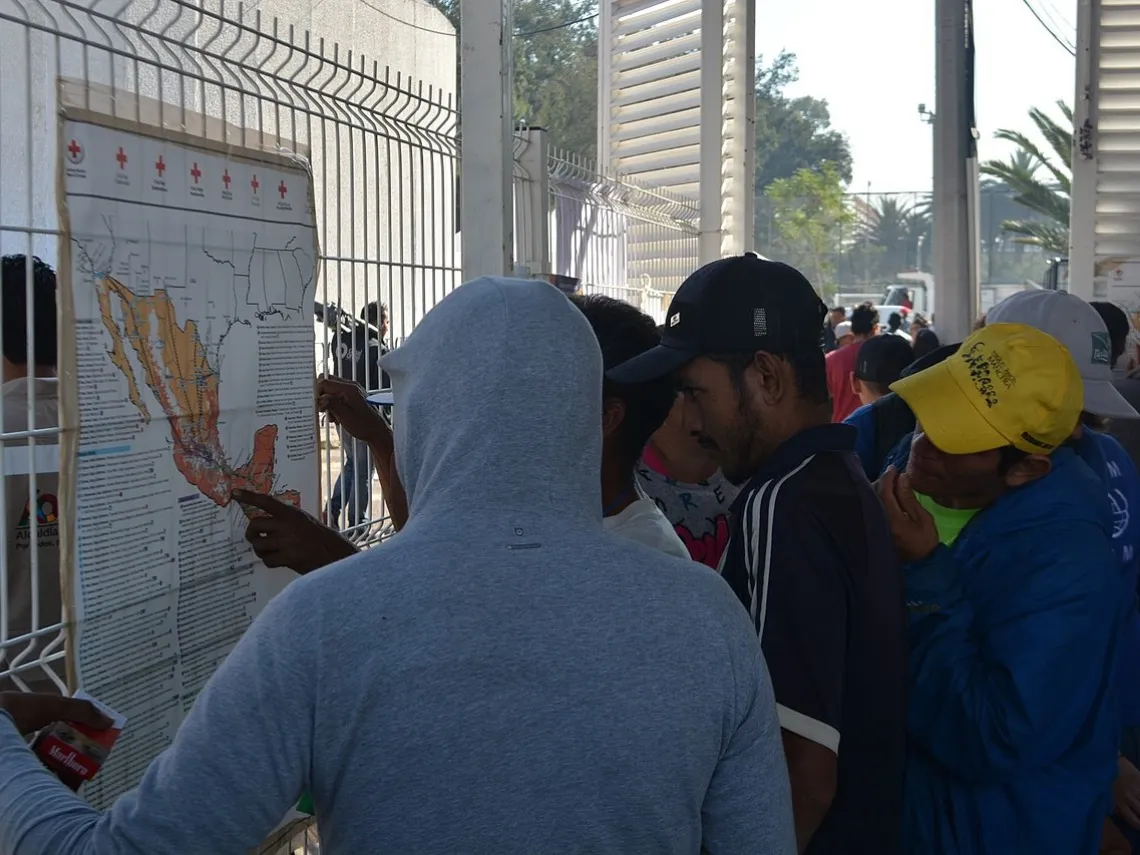Analyzing Migration Patterns From Central America
With a grant from the Department of Defense, UArizona researchers will use natural language processing and machine learning to analyze migration patterns.

Migrants looking for routes on a map of Mexico at Ciudad Deportiva Magdalena Mixhuca temporary camp, Mexico City. (Creative Commons)
Understanding variations in Central American migration patterns through Mexico into the United States is important for U.S. domestic and national security policies and debates, as well as the work of many nonprofit groups.
With a new grant from the federal government, University of Arizona researchers will look at what explains those variations by analyzing migration patterns from Central America, using natural language processing and machine learning.
"Given that the convergence of deteriorating security conditions, economic crisis and climate change is likely to increase migration flows in Latin America over the next three decades, few questions are more deserving of attention and empirical investigation," said researcher Javier Osorio, assistant professor in the UArizona School of Government and Public Policy in the College of Social and Behavioral Sciences.
UArizona's designation as a Hispanic-Serving Institution made the university eligible to apply for the grant from the Department of Defense's Army Research Office, part of the U.S. Army Combat Capabilities Development Command's Army Research Laboratory. Made under the Historically Black Colleges and Universities and Minority‐Serving Institutions Science Program, grants were awarded to projects that advance technologies relevant to national defense, including artificial intelligence, machine learning, autonomous vehicles, big data analytics and quantum computing.
"Immigration is a growing global phenomenon, but there is very little systematic research on what drives different groups to decide to undertake the risky decision to immigrate," said Lisa Troyer, Army Research Office program manager for social science. "This project offers a rigorous and innovative analytic approach to generate a much-needed scientific understanding of immigration dynamics."
Osorio, along with Alex Braithwaite, a professor in the School of Government and Public Policy, are the principal investigators of the $660,000, three-year grant.

Javier Osorio
"We will be looking at how local security conditions and environmental stressors motivate migration flows from Central America to the U.S.," Osorio said. "And we're going to do that in an innovative manner, considering not only factors in the countries of origin, but also the routes that migrants follow from Central America, through Mexico, all the way to entry points in the U.S."
Their research will consider some of the motivators of migration, including threats of gang violence, natural disasters and political crises in origin countries, as well as the desire to access U.S. economic opportunities. Osorio noted that poverty – an important trigger of migration – has been exacerbated by COVID-19.
The researchers also will examine the costs of migration, including the long and dangerous journey to the U.S. and tougher immigration policies in destination countries. These costs may be reduced by social networks, religious organizations and bandwagons of migrant caravans.
Using Technology to Create a Model of Migration
The researchers plan to use natural language processing to analyze more than 14 million anonymized records of migrant apprehensions in the U.S. and Mexico between 2000 and 2019. Osorio emphasized that they will need to get permission from various government agencies both in the U.S. and Mexico to gain access to the data.
The researchers will be able to disentangle the migration patterns of single adult males, single adult females, unaccompanied minors and family units.
"We can learn about the conditions that forced people to migrate, because these are part of the conversations that they have with immigration officers, especially when they seek asylum," Osorio said. "The information in these documents is hardly ever analyzed."
Through machine learning and computerized coding of Spanish newspapers, the researchers will obtain data on the presence of street gangs in Central America, calculate political instability, and track caravans of migrants throughout the region.
The researchers will use geographic information systems, or GIS, to generate data on natural disasters, including droughts, hurricanes and earthquakes. GIS tools can also calculate the most efficient migration routes and generate models of congestion that are likely to attract more people to join migration caravans.
A Novel Approach to Understanding Migration
Osorio said that many current approaches to understanding migration focus on what happens at the border and do not follow the entire trajectory of migration.
"We want to connect the stressors at the point of origin, through the route, all the way up to the point of entry," Osorio said.

Alex Braithwaite
Braithwaite added that some migration researchers look at large patterns of data without examining individual cases. Others have taken a more anthropological approach, creating ethnographies on particular people or journeys.
"A lot is learned from both of those approaches," Braithwaite said. "The ambition here is to pull together these two approaches, to include the richness of individual stories and the representativeness and generalizability of large amounts of data."
The results of the research, both scholars say, should be of interest to a variety of audiences.
"Everybody benefits from a better understanding of when and why people will migrate, including relief agencies," Braithwaite said.
Involving Students in Research
Part of the grant funds will be used to hire postdoctoral researchers to help with the study. Osorio and Braithwaite also want to involve undergraduates in the research experience, most likely in connection with a course on data collection planned with SGPP’s newly formed Arizona Policy Lab.
Osorio said the project also has synergies with a new grant received by the Center for Latin American Studies from the Department of Education that supports curriculum development related to Central America.

